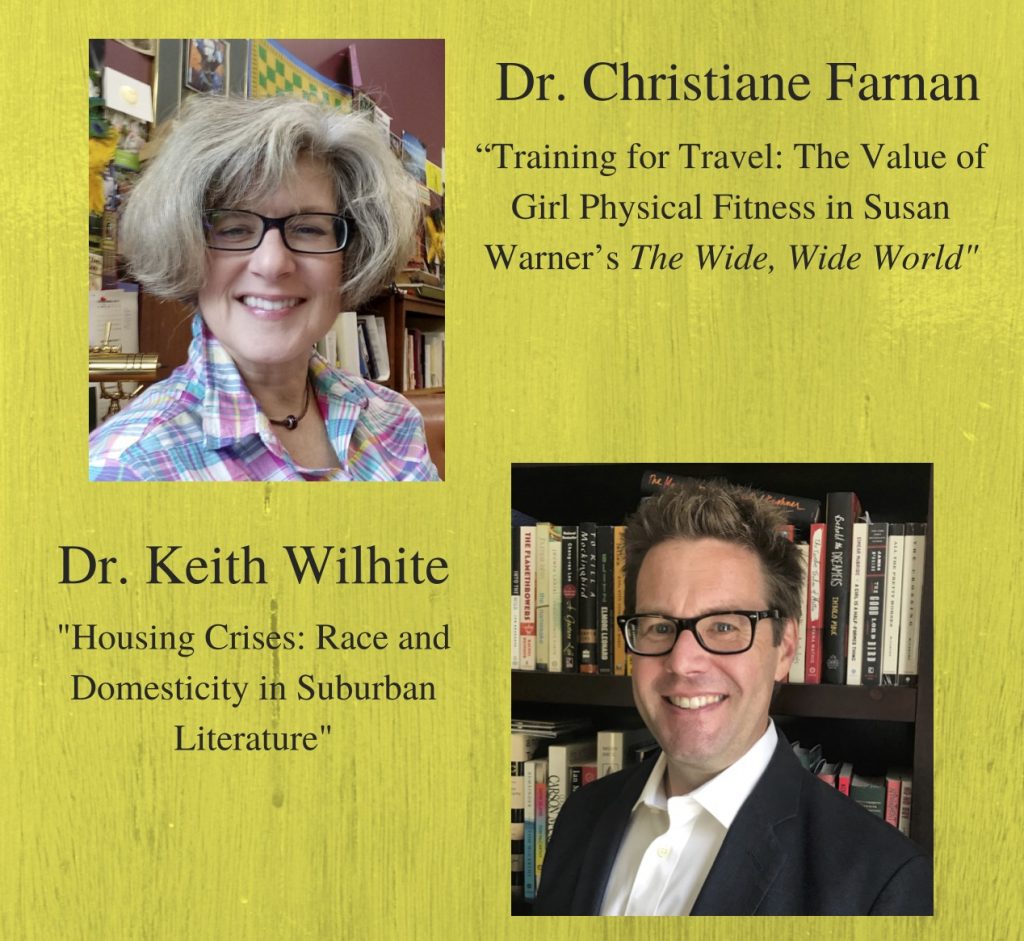On Tues. Oct. 30, 2018, the English Department held a colloquium featuring professor research by Dr. Keith Wilhite and Dr. Christiane Farnan. Dr. Wilhite is an assistant professor of English and has a primary focus in urban and suburban studies. Dr. Farnan is also an associate professor of English who focuses in mid-nineteenth to early-twentieth-century women writers. Both professors were on sabbatical last semester and spent their time extensively researching and writing their current book projects. The event drew in students of all disciplines who were interested in learning more about their professors’ projects.
Dr. Wilhite spent his semester-long sabbatical working on a book chapter about nation-building, domestic security, and the suburban ideal in postwar America. His research focuses on the changes in suburban life from 1945, post-World War II, to the 2008 recession and is a scrutinization of the “cultural ideal of [the] suburban home.” Dr. Wilhite used examples of film and media magazines while presenting his research findings, specifically those that promoted the suburban ideal. He showed stills from “Mr. Blandings Builds His Dream House” (1948), a film that reflected the need for housing post-WWII, as the urban space of the city was becoming too cramped. Dr. Wilhite also showed images of House and Garden Magazine. The magazine’s depiction of suburban nation-building suggested that the home “embodie[d] the American ideal of good living,” as well as a right that the WWII veterans fought for. However, House and Garden did not reference the exclusivity of this vision, Dr. Wilhite explained. There were limited options for African-Americans moving from the rural south to the suburbs.
Expanding on these limited options for African-Americans looking to achieve this suburban ideal, Dr. Wilhite then discussed his analysis of the 1959 play, “A Raisin in the Sun,” by Lorraine Hansberry, in relation to his project. The play, set in the South Side of Chicago in the 1950s, shows the life of the Youngers, an African-American family who comes into conflict over how to spend a life insurance check. As the play progresses, the family puts a down payment on a house in Clybourne Park, an entirely white neighborhood and experiences racial discrimination. One of the sons, Walter Lee, envisions the suburban ideal during the play: a commute home from downtown, his help waiting to greet him in the yard, and the dutiful wife waiting at the door to welcome him home with a kiss. Dr. Wilhite explained these are “recognizable signifiers of white male fantasy and power that Walter reads as a universal path to success.” Dr. Wilhite concluded his presentation with a reading from one of his chapters.
Dr. Farnan spent her sabbatical researching female physical fitness in the nineteenth century. She directed her focus to Ellen Montgomery’s character in “The Wide, Wide World” by Susan Warner. Warner’s book, published in 1850, was the biggest bestseller of the nineteenth century from 1850 to 1852 until “Uncle Tom’s Cabin” was published. Despite its literary success, however, many students have not heard of or read the novel. Dr. Farnan brought her personal copy of “The Wide, Wide World” to the colloquium and held it up for the audience to see – her copies were split into two volumes with red covers and silver script, which were heavily worn. “When I hold this in my hand, I feel like I’m reading it the way the original readers enjoyed it,” she said.
After setting up the historical and literary context for Warner’s book, Dr. Farnan explained her main argument of the novel: “I argue that Susan Warner presents the mid-nineteenth century American girl abroad as a different, unusually athletic, more interesting kind of mid-nineteenth century girl.” Dr. Farnan emphasized that the protagonist of “The Wide, Wide World,” Ellen Montgomery, predates Louisa May Alcott’s Jo March of “Little Women” by two full decades. Fans of Alcott’s recognize Jo’s character as defying society’s expectations of femininity. Ellen’s character in Warner’s novel is strong – mentally, physically, spiritually. Through the course of the novel, she travels from New York City to the Adirondacks to Edinburgh, Scotland, a journey that reflects her endurance and strength.
Dr. Farnan questioned why there was no social pushback to this athletic, hardy female protagonist who, on the surface-level, defied patriarchal expectations. During her sabbatical, she pursued this question further and determined that “Ellen’s character always adheres to prescribed methods by which a domestic heroine overcomes her obstacles.” Dr. Farnan explained, “She never steps out of culturally prescribed behavior.” Though Ellen’s character exercises and actively maintains physical fitness, she is always, still, in submission to patriarchal authority. Farnan explained that Ellen is described as “perfectly ladylike” by other characters in the novel, even when she is engaged in strenuous activity.
It was a valuable opportunity for students to hear about Dr. Wilhite and Dr. Farnan’s research projects. Students often are unaware of the additional work and research professors engage in outside of the classroom, and it is important for all of their hard work to be recognized.

